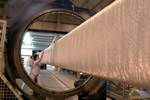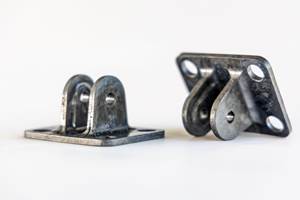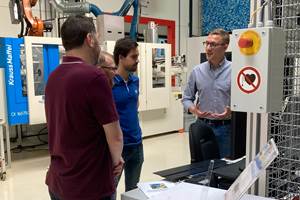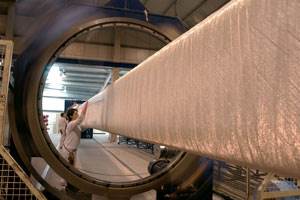High Wind in China
China's renewable energy mandates motivate huge growth in its wind energy market, spurring production of composite components on the Chinese mainland.
Currently the sixth-largest wind energy market in the world, with close to 2,620 MW of installed capacity, China also ranks fifth in the amount of wind power generating capacity installed in 2006, adding more than 1,370 MW of new capacity. Although that represents half of the capacity installed in the U.S. during the same period, it also accounts for less than 1 percent of China’s annual demand for electricity. China, in fact, is second only to the U.S. as a consumer of electricity and has the fastest growing energy demand in the world. That leaves room for huge growth in wind energy.
Determined to reduce its dependence on coal and imported oil, China’s centralized government enacted the Renewable Energy Law (effective Jan. 1, 2006), which mandates that at least 5 percent of electricity must be generated from renewable sources by 2010 and 10 percent by 2020. To meet that goal, China must have 30,000 MW (or 30 gigawatts) of wind power capacity by 2020, which translates into roughly 2,100 MW installed per year for the next 13 years. Further, the law requires that 70 percent of China’s wind power components be sourced locally by 2010, and it offers financial incentives, including a national fund intended to foster development of renewable energy as well as discounted lending and tax relief. Given this encouragement, analysts such as Credit Suisse forecast that wind power capacity in China will grow 39 percent annually from 2004 to 2010 and 20 percent annually from 2010 to 2020. According to industry estimates in 2006, China will spend $200 billion (USD) on renewable energy during that period.
China’s renewable energy mandate has dramatically changed the country’s wind energy landscape. At the end of 2000, there were roughly 10 wind turbine manufacturers in China, but only five produced turbines of 600 kW or greater. By late 2006, however, there were more than 30 turbine manufacturers — 24 domestic and at least seven foreign either producing or preparing to produce turbine components on Chinese soil. Given the demand for electric power and Beijing’s incentives, experts believe the number of players will continue to increase.
Although they are more numerous, Chinese companies initially lagged behind foreign-based manufacturers, producing less than a quarter of China’s installed turbines, in part because domestic manufacturers have been slower to ramp up to utility-scale (1 MW or larger) turbines. Also, domestic turbines usually featured fixed-pitch, constant-speed control systems, which are less efficient than the variable-pitch, variable-speed control systems now common in the West.
Technology Acquisitions and Joint Ventures
To close the technology gap, many Chinese manufacturers have acquired foreign technology, either by purchasing production licenses from or by forming joint ventures/cooperative agreements with major turbine producers. Although licenses commonly give Chinese companies more control, the most accessible technology is usually somewhat outdated. Cooperative development, by contrast, grants domestic turbine manufacturers access to newer designs and the right to manufacture turbines locally, albeit with greater foreign involvement.
Early domestic players were sometimes the result of “arranged marriages.” China’s former State Development and Planning Commission’s (SDPC) 1997 “Ride the Wind Program,” for example, encouraged the import of wind power technology to kick-start domestic turbine manufacturing. The program spawned two joint ventures (JVs); these started with a 20 percent local content requirement, with a goal to increase to 80 percent as experience allowed.
The first JV, Yituo-MADE (Luoyang) Wind Turbine Co. (Luoyang, Henan Province), was formed by Spain-based MADE Renewable Technology and Luoyang-based China YiTuo Group. By 2000, the company was producing 330-kW and 660-kW turbines, with the latter 60 percent locally sourced. Yituo-MADE, is now defunct and MADE filed for bankruptcy in 2003 and was bought by Spanish turbine manufacturer Gamesa Eólica SA (Victoria, Spain). The second JV, Xi’an Nordex Wind Turbine Co. Ltd. (Xi’an, Shaanxi Province), was a 40/60 arrangement between Nordex (Norderstedt, Germany) and Xi’an Aero-Engine Group, which produced a 600-kW wind turbine.
Both JVs met with limited success in part because the selected Chinese aerospace industry companies had little experience or interest in manufacturing turbines. Xi’an Nordex, however, remains active, producing both 600-kW and 250-kW turbines, with a capacity of between 150 and 250 units annually.
Among the original group of domestic producers, Goldwind Science and Technology Co. Ltd. (Urumqi, Xinjiang Province) is China’s oldest, largest and most experienced manufacturer. Goldwind’s 20 percent share of the Chinese market in 2005 has grown, some sources say, to as much as 40 percent, thanks not only to the Renewable Energy Law’s local-content mandate but its early push to produce turbines of 1.5 MW and larger, as well.
Goldwind was founded in 1997 when Urumqi-based parent company Xinjiang Wind Energy Co. Ltd. bought a license to manufacture 600-kW wind turbines from Jacobs Energie GmbH, now part of global turbine manufacturer REpower Systems AG (Hamburg, Germany). Goldwind turbines are 90 percent locally produced, including the rotor blades, which are supplied to Goldwind by Zhonghang (Baoding) Huiteng Windpower Equipment Co. Ltd. (Baoding, China).
Goldwind first licensed REpower’s 48-kW to 750-kW turbine technology in 2002 and then acquired a license in 2003 from Vensys Energiesysteme GmbH (Saarbrücken, Germany) for its Vensys 62 1.2-MW turbine (62m/205-ft rotor diameter). When Vensys developed a low wind speed version with a larger 64m/211-ft diameter rotor that increased output to 1.5 MW, Goldwind acquired the license for that turbine as well and is currently working with Vensys to produce 2.0-MW and 2.5-MW turbines. Goldwind hopes to begin manufacture this year and will supply offshore wind farms. Its 2006 production goal — collective turbine capacity of 300 MW to 400 MW — was doubled for 2007.
Goldwind recently beat out foreign and domestic competitors to win the contract for 33 wind turbines (1.5-MW Vensys 77 systems) for the 2008 Olympic Games in Beijing. The company operates plants in Xinjiang, Guangdong, Zhejiang and Hebei Provinces and is building plants in Beijing and Inner Mongolia. In February, Goldwind signed a six-year contract with LM Glasfiber (Lunderskov, Denmark) to supply blades for Vensys 70 and 77 turbines and develop blades for Goldwind’s next generation of 2-MW and larger turbines at LM’s factory in Tianjin.
Gaining ground on the leaders is Zhejiang Yunda Windey (Hangzhou City, Zhejiang Province), which licensed 600-kW and 750-kW production technology, installation and after-sales service from REpower in 2002, earning a reported 1.4 percent share of the Chinese turbine market in 2005. While early models relied heavily on imported components, the company today claims 80 percent local content for its 750-kW unit and 100 percent localization of its 250-kW unit. The company’s 20,000m² (215,278-ft²) facility can produce 100 sets of each system annually. In December 2006, the company signed an agreement with Bristol, U.K.-based wind power consultancy Garrad Hassan to obtain engineering design and training support for the development of new 1.5-MW wind turbines. Also, the state-owned China Energy Conservation Investment Corp. (CECIC, Beijing), recently bought a 47.5 percent stake in the company. CECIC’s wholly owned subsidiary, Beijing Guotou Energy Conservation Co. (Beijing), is developing the Zhangbei Manjing I wind farm in Hebei Province (planned for 45 MW to 1 GW of capacity) and also operates the 45-MW TuoLi project in Xinjiang, which is slated for an additional 55 MW of development. Zhejiang Yunda Windey is supplying turbines for both projects.
Among the licensed Chinese manufacturers of utility-scale turbines are two that entered the domestic wind power market with 1 MW or larger turbines. In 2004, Dongfang Steam Turbine Works (DFSTW, Deyang, Sichuan Province) licensed REpower’s 1.5-MW turbine technology, producing turbines and installing four units in 2005. Although it was said to have only 1.2 percent of the Chinese wind turbine market that year, DFSTW is now considered one of the top three domestic manufacturers. The REpower license was extended to permit local manufacture of the MD 77 1.5-MW and MM 77 2.0-MW units in 2006. DFSTW reportedly has annual production of 200 turbines (300 MW capacity). In April, DFSTW contracted with Windtec, a wholly owned subsidiary of American Superconductor Corp. (AMSC, Westborough, Mass.) for Windtec-developed 2.5-MW systems. DFSTW plans to begin production of the 2.5-MW systems by the end of 2009. In a 2006 news report, DFSTW, REpower and the Qingdao Municipality signed a memorandum of understanding to build one of the first offshore wind farms in China, a demonstration project of five 5-MW turbines.
Joint Ventures Spur Quick Development
In December 2005, Nordex launched a joint venture with two companies in Ningxia Province to produce MW-class turbines. Ningxia Electric Power Group and the Ningxia Tianjing Electric Energy Development Group will own 40 percent and 10 percent of the venture, respectively, while Nordex assumes the remaining 50 percent. This was a strategic move because both Chinese companies are owners of the Helanshan wind farm, one of the largest wind projects in China with 110 MW of installed capacity and massive expansion expected. Representing a total investment of $12 million, the JV, Nordex Wind Power Equipment Manufacturing Co. Ltd. (Yinchuan, Ningxia Province), produced its first 1.5-MW turbines in November 2006 for its first major order of more than 130 turbines or 200 MW.
In 2001, Nordex also acquired a 66.67 percent stake in Qingdao Huawei Wind Power Co. Ltd. (Qingdao, Shandong Province) to develop the Qingdao wind farm for Qingdao-based Chinese partner Dongyi Industrial Corp. Twelve 1.3-MW turbines operate there.
Perhaps the most successful JV to date is Nantong CASC Wanyuan Acciona Wind Turbine Manufacture Co. Ltd. (NCWA, Nantong City, Jiangsu Province), created in 2005. Formed between Acciona Energia (Sarriguren, Navarra, Spain) and CASC, a state-owned aerospace conglomerate that develops, manufactures and launches space system vehicles, Acciona has installed 3,674 MW of wind energy systems on 137 farms in nine countries and has ownership interest in 2,492 MW of these. The company has three facilities that can produce up to 1,120 turbines annually.
Acciona and CASC each own 45 percent of NCWA, with the remaining 10 percent held by Hispano-Chinese marketing firm Inceisa. A relative newcomer to the industry, Acciona began production in 2004, manufacturing 576 units by year-end 2006, a three-year total it expects to match in 2007 alone. The company has developed a 3-MW turbine that it hopes to put into production soon.
In 2006, NCWA opened a $31 million factory in Nantong — at 103,000m² (more than 1.1 million ft²), it was then the largest of its kind in China — with an annual capacity of 400 units (600 MW). The facility will manufacture AW-1500 1.5-MW turbines, with rotor blades as long as 40m/130 ft. A second phase is expected to increase capacity to 900 turbines per year. Its first delivery was for 33 turbines modified for low-temperature operation that were installed in the 49.5-MW Zhangbei wind farm, developed by the China Guotou group in Hebei Province. It also signed an agreement to supply 67 turbines between October 2006 and February 2007 for the 100.5-MW LongYuan Qidong farm for the China Longyuan Guodian Group in Jiangsu Province.
In May 2006, LM Glasfiber announced it had completed a long-term supply agreement with NCWA in which LM will produce blades for NCWA’s 1.5-MW turbines from LM’s factory in Tianjin.
In addition to licensing agreements with domestic manufacturers, REpower established in 2006 a joint venture, REpower North, to produce its own turbines in Baotou, Inner Mongolia, a region that has 40 percent of China’s total wind resources (reportedly enough to provide 300,000 MW of power). Partners include state-owned steel and heavy construction equipment manufacturer North Heavy Industry Corp. (NHIC, Baotou, Inner Mongolia) and London, U.K.-based wind farm developer Honiton Energy Ltd., which had already committed 650 million yuan ($85.2 million) for wind farm developments in the region.
REpower North plans to install 100 MM70 and MM82 2.0-MW turbines in 2008, manufactured mostly from Chinese-produced components. The company also plans to double production capacity each year until 2010, with final capacity of 400 2-MW turbines per year, nearly half of which are destined for Inner Mongolia.
Foreign Companies Put Down Roots
The “local source” provision of China’s Renewable Energy Law has motivated most of the major foreign wind companies to build factories in China. For example, while Nordex considers its joint ventures as a good starting base for its efforts in China, it has realigned its activities to “intensify our local added value for larger machines,” according to Eberhard von Perfall, head of the Nordex Supervisory Board, by investing heavily in wholly owned production capacity. In early 2005, Nordex opened a new 4,000m² (43,055-ft²) blade production facility in Baoding (Hebei Province), where it is said to be producing 99 blades per year as well as other components for its N60 (60m/197-ft diameter) 1.3-MW turbines. In January, Nordex opened a new rotor blade factory in Dongying (Shandong Province). Constructed in a record six months, the Nordex (Dongying) Wind Power Equipment Manufacturing Co. facility represents a €20 million ($26.8 million USD) investment. The company plans to use its initial production area of 8,400m² (90,417 ft²) to build blades this year for 1.5-MW turbines produced at its Ningxia facility, eventually ramping up to 800 blades (400 MW) annually. Nordex is planning additional production sites in China to satisfy strong local demand.
In 2005, Vestas AG (Randers, Denmark) opened a new $30 million plant in China’s Tianjin Economic-Technological Development Area (TEDA) to produce 39m/128-ft blades for its V80 2-MW turbines. A wind power leader with 25 to 28 percent of worldwide turbine sales, Vestas built the world’s first offshore wind farm in Europe and was reported to own 38 percent of China’s wind turbine market in 2005. It got a head start when it merged with Randers-based NEG Micon in 2003, which had already earned a 29 percent share of the Chinese market. By the end of 2006, Vestas had 666 installed turbines in China.
The Vestas factory is expanding. Capacity will increase from 600 to 1200 blades by mid-2007 — an annual installed capacity of 800 MW. With 285 employees in Tianjin at the end of 2006, Vestas announced that it also will establish a $23 million plant for the assembly of glass/polyester nacelles and cast iron hubs at the TEDA complex, with an annual capacity of 350 nacelles and hub assemblies.
Spain’s largest wind power producer, Gamesa Eólica, is part of the Spanish Gamesa group, which also owns wind farm developer Gamesa Energia, a partner in delivering turnkey projects, including complete wind farms. In 2003, Gamesa Eólica acquired Spanish wind turbine manufacturer MADE Energias Renovables SA (Madrid), from Spanish utility Endesa, increasing its global market share to 15 percent and gaining good growth potential from Endesa’s large wind farm project pipeline. Gamesa offers 850-kW and 2.0-MW turbines.
Gamesa began commercial activity in China in 1997. By 2005, it became the second largest foreign turbine manufacturer controlling 36 percent of the Chinese market, according to BTM Consult (Ringkøbing, Denmark). Gamesa Energia began wind farm development in China in 2005 and amassed projects in nine Chinese provinces by 2006. Gamesa Eólica commissioned its first factory in China in 2006, a 41,644m² (448,252-ft²) plant at Huayuan Technology Park in Tianjin, slated to produce 400 MW of its G5X 850-kW turbines each year. A second plant at the same site manufactures blades for its G5X wind turbines. This wholly owned subsidiary, Gamesa Wind Tianjin, claimed to have 1,200 MW of wind capacity on its order books by September 2006, including the largest single order ever awarded in China: 601 wind turbines (worth €240 million or about $320 million) for Longyuan Electric Power Group wind farms, with a total capacity of 510 MW.
Having established a small foothold in the Chinese turbine market in 2005, GE Wind Energy (Tehachapi, Calif.) opened its first wind turbine assembly plant in 2006, in Shenyang (Liaoning Province), next to two other GE facilities. One of the latter, the GE Energy (Shenyang) Co. Ltd. facility, a wholly owned subsidiary, will produce 1.5-MW turbines. GE’s installed base includes 30 turbines with 77m/253-ft-long blades (the longest in China at the time of manufacture) in the Zhangbei Guotou Wind Power Plant (Hebei Province, northwest of Beijing). This project could field as many as 1,000 turbines on a series of new wind farms by 2010. GE also installed 67 1.5-MW units in 2006 for the Jiangsu Rudong Concession II Wind Project in Shenyang. The remaining 33 units for the 150-MW wind farm were to be installed this year.
Suzlon (Pune, India), which ranks sixth worldwide in wind turbine production, opened an $80 million (USD) factory in the eastern Chinese port city of Tianjin earlier this year. The 250,000m² (2,690,977-ft²) plant — Suzlon’s and China’s largest wind turbine plant to date — will fabricate generators and integrate rotor blades, nacelles and control panels, with an annual capacity of 600 MW to 800 MW. Suzlon plans eventually to erect six more plants, a maintenance center and a technology center.
Home-Grown Technology
While the market seems large enough to accommodate foreign and domestic producers, wind farm developers (ac-cording to current estimates) can acquire a domestically produced turbine for two-thirds the cost of a foreign equivalent. Because turbines comprise 60 to 70 percent of the overall wind farm development expense, Chinese wind farm developers likely will push for increased domestic production, and Chinese equipment manufacturers will continue their drive to acquire the expertise to build complete wind turbines locally. Therefore, new companies are entering the market, often from related industries, and industry analysts believe this will continue — a phenomenon that eventually will reduce wind turbine prices not only in China but worldwide.
Among the newcomers is Harbin Hafei-Winwind Wind Power Equipment Co. Ltd. (Harbin, Heilongjiang Province), a 2004 startup that completed testing of a 1.2-MW turbine design in early 2006 with production to start by year’s end. Formed in 2004, the company says its new turbine was developed independently from its own design and intellectual property — a first for a domestic Chinese manufacturer. It is a joint venture between Winwind (Oulu, Finland) and Harbin Hafei Mechanical & Electrical Products Manufacturing Co. Ltd. (a subsidiary of Harbin Power Equipment Group, one of the largest producers of electrical generators in China). Shanghai Electric Group Corp. (SEC, Shanghai) — China’s largest producer of electrical equipment — has established a branch institute in Shanghai Dianji University, targeting R&D for Shanghai-made turbines. Although SEC currently manufactures 1-MW wind turbine generators, a company official revealed that “SEC intends to develop a ‘Shanghai home-grown technique’ to produce 2-MW turbine generators.” Reportedly, SEC will cooperate with three local universities in research on the project and will apply the technology to wind farms in Shanghai’s Nanhui and Chongming Districts.
Chinese Wind Blade Manufacturers
Wind blades consume the bulk of the composites in a turbine, although most manufacturers use fiberglass/polyester nacelles to house the turbine drivetrain. Because blade construction tends to be the most labor-intensive portion of turbine manufacture, turbine producers have made local blade factories a priority — Vestas, for example, opened its blade plant prior to its turbine assembly facility. Domestic wind blade manufacturers are starting to multiply as well.
Zhonghang (Baoding) Huiteng Windpower Equipment Co. Ltd. (HT Blade), is a U.S.-China cooperative enterprise established in 2001 and owned by Tang Energy Group Ltd. (Dallas, Texas), Baoding Huiyang Aviation Propeller Factory, and China Aviation Gas-Turbine Power (Group) Corp. HT Blade has acquired a majority share of the Chinese-made blade and nacelle cover market. It is now preparing to export blades. The company began commercial production with 600-kW wind turbine blades in 2001 and in 2005, began producing larger blades in line with the Chinese market trend toward higher-rated, more efficient turbines. HT Blade now is developing blades for turbines as large as 3.0 MW. HT Blade’s annual production capacity is 400 sets of 600-kW blades, 1000 sets of 750-kW blades and 200 to 500 sets of MW-series blades.
Big Land, Big Opportunities
The Chinese wind energy market has composite materials suppliers busy positioning products for wind blade applications. Huntsman Advanced Materials (Schaffhausen, Switzerland and Woodlands, Texas), for example, makes epoxy resins specifically for wind blade production. Chambery, France-based Saint-Gobain Vetrotex has established an Asia-Pacific office in Shanghai to promote its continuous glass fiber fabrics for wind blade production, while Toledo, Ohio-based Owens Corning has developed new Windstrand glass fiber specifically for the same application. Closer to home, CPIC/Fiberglass (Chongqing, China) markets domestic E-glass and E-CR glass to local wind blade factories. Gurit (Wattwil, Switzerland) established a distribution base in Tianjin after it acquired SP Systems three years ago. Gurit’s Wind Energy Business Unit accounted for 50 percent of the company’s 2006 sales and, according to the firm, a 15 percent share of the overall composites market in wind energy. Gurit supplies epoxy gel coats, adhesives, laminating and infusion resins, glass and carbon prepregs and Corecell foam. Carbon fiber, a key component of spars used in some of the longer blades for multimegawatt turbines, is making inroads in China, although more slowly than in the West. Two key carbon suppliers in that push are Toray Industries (Tokyo, Japan) and St. Louis, Mo.-based Zoltek Inc. The use of carbon and prospects for its growth in wind blade construction are discussed this in HPC’s “Carbon in the Wind” feature (see “Related Content,” at left).
What’s become abundantly clear is that the Chinese market for composites in wind energy systems is in the midst of rapid growth and expansion that will merit this industry’s close scrutiny in the years to come.
Related Content
Chemnitz University of Technology receives €6 million to expand research into "green" carbon fiber
Carbon LabFactory and InnoCarbEnergy project conduct R&D across entire value chain from raw materials through processes to structures and systems on a pilot line with technology demonstrators.
Read More9T Labs, Purdue University to advance composites use in structural aerospace applications
Partnership defines new standard of accessibility to produce 3D-printed structural composite parts as easily as metal alternatives via Additive Fusion Technology, workflow tools.
Read MoreSustainability has come to composites and it's here to stay
It might be tempting to think of sustainability as a buzzword, but there are structural changes taking place in the composites industry that signal its permanence.
Read MoreTPRC training courses target thermoplastic composites
Three upcoming in-person thermoplastic composites courses, ranging from entry-level to advanced, are organized to enhance composites professionals’ knowledge in this burgeoning field.
Read MoreRead Next
Carbon Fiber in the Wind
Is there a market for carbon composites in wind turbine blade construction? Yes, but the real question is, how big will it be?
Read MoreCW’s 2024 Top Shops survey offers new approach to benchmarking
Respondents that complete the survey by April 30, 2024, have the chance to be recognized as an honoree.
Read MoreComposites end markets: Energy (2024)
Composites are used widely in oil/gas, wind and other renewable energy applications. Despite market challenges, growth potential and innovation for composites continue.
Read More















.jpg;maxWidth=300;quality=90)










